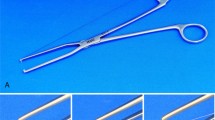Abstract
The prevention of middle turbinate lateralization, and middle meatal synechiae formation, is the key to maintain a patent ostiomeatal complex following endoscopic sino-nasal surgery (ESS). Different techniques have been described to prevent this undesirable outcome, however, most of them are invasive, expensive, uncomfortable and/or obstructive. We present our technique to modified silastic sheets to circumvent these problems and improve ventilation and drainage of sinuses after surgery. The aim of this paper is to present how this silastic sheeting can be easily customized to the shape of the ethmoid cavity after ESS, allowing for ventilation of the aerated sinonasal cavities and at the same time preventing problematic synechiae/scar formation. A practical and easy technique to customize silastic stents following ESS is presented. Silastic sheets could be easily customized of the ethmoid cavity after ESS providing an excellent alternative to reduce middle turbinate lateralization and synechiae formation.






Similar content being viewed by others
References
Scheithauer MO (2010) Surgery of the turbinates and ‘‘empty nose’’ syndrome (in German). Laryngorhinootologie 89(suppl 1):S79–S102
Hewitt KM, Orlandi RR (2008) Suture medialization of the middle turbinates during endoscopic sinus surgery. Ear Nose Throat J 87:E11
Bhalla RK, Kaushik V, de Carpentier J (2005) Conchopexy suture to prevent middle turbinate lateralisation and septal haematoma after endoscopic sinus surgery. Rhinology. 43:143–145
Chung JH, Cosenza MJ, Rahbar R et al (2002) Mitomycin C for the prevention of adhesion formation after endoscopic sinus surgery: a randomized, controlled study. Otolaryngol Head Neck Surg 126:468–474
Friedman M, Schalch P (2008) Middle turbinate medialization with bovine serum albumin tissue adhesive (Bioglue). Laryngoscope 118:335–338
Freidman M, Landsberg R, Tanyeri H (2000) Middle turbinate medialization and preservation in endoscopic sinus surgery. Otolaryngol Head Neck Surg 123(1 Pt 1):76–80
Shih C, Chin G, Rice DH (2003) Middle turbinate resection: impact on outcomes in endoscopic sinus surgery. Ear Nose Throat J 82:796–797
Shrime MG, Tabaee A, Hsu AK et al (2007) Synechia formation after endoscopic sinus surgery and middle turbinate medialization with and without floseal. Am J Rhinol 21:174–179
Shoman N, Gherianni H, Flamer D et al (2009) Prospective, double-blind, randomized trial evaluating patient satisfaction, bleeding, and wound healing using biodegradable synthetic polyurethane foam (Nasopore) as a middle meatal spacer in functional endoscopic sinus surgery. J Otolaryngol Head Neck Surg 38:112–118
Lee JY, Lee SW (2007) Preventing lateral synechia formation after endoscopic sinus surgery with a silastic sheet. Arch Otolaryngol Head Neck Surg 133:776–779
Chan CL, Elimiyeh B, Woods C et al (2015) A randomized controlled trial of a middle meatal silastic stent for reducing adhesions and middle turbinate lateralization following endoscopic sinus surgery. Int Forum Allergy Rhinol 5(6):517–523
Moukarzel N, Nehme’ A, Mansour S et al (2000) Middle turbinate medialization technique in functional endoscopic sinus surgery. J Otolaryngol 29:144–147
Author information
Authors and Affiliations
Corresponding author
Ethics declarations
Conflict of interest
The authors declare that they have no conflict of interest.
Rights and permissions
About this article
Cite this article
Hartl, T.T., Ospina, J. & Janjua, A. Silastic “Spring” Spacers for Use Following Endoscopic Sinus Surgery. Indian J Otolaryngol Head Neck Surg 71, 233–237 (2019). https://doi.org/10.1007/s12070-018-1459-4
Received:
Accepted:
Published:
Issue Date:
DOI: https://doi.org/10.1007/s12070-018-1459-4




